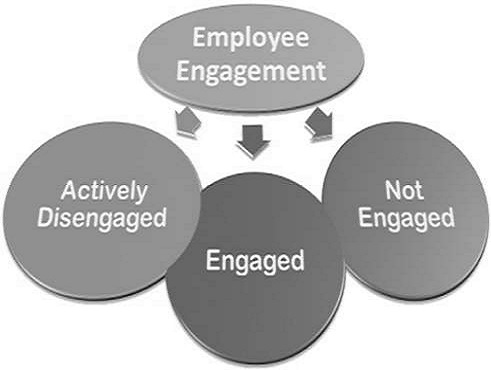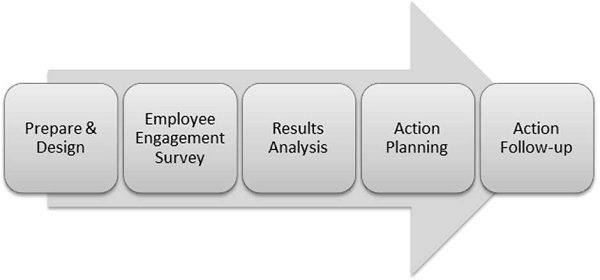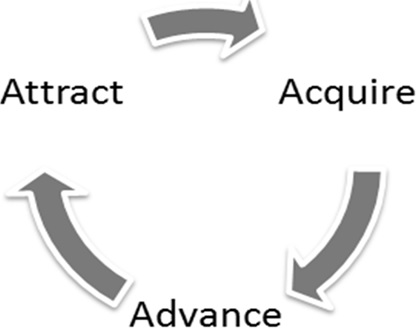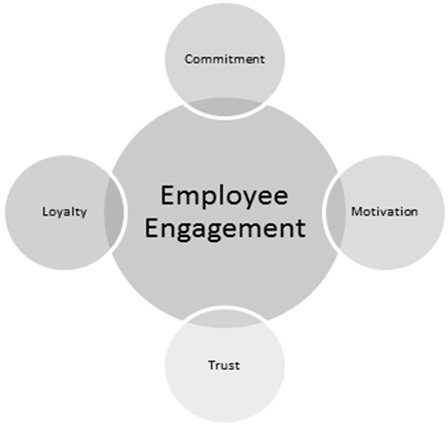
- Employee Engagement - Home
- Introduction
- Employee Engagement - Types
- Steps for Success
- Employee Engagement - The 10 C's
- Employee Engagement - Process
- Employee Engagement - Phases
- Employee Engagement - Strategies
- How to Engage Women Employees?
- Employee Engagement - Drivers
- How to Meaure?
- Effective Methods
- Management Role
- Employee Engagement - Activities
- Employee Engagement - Benefits
- Problems of Disengagement
Employee Engagement - Quick Guide
Employee Engagement - Introduction
Employee Engagement is a workplace approach resulting in the right conditions for all members of an organization to give their best each day. Employee Engagement is based on trust, integrity, a two-way commitment and communication between an organization and its members. It is an approach that increases the chances of business success, contributing to organizational and individual performance, productivity and well-being.
From an employer's point of view, employee engagement is concerned with using new measures and initiatives to increase the positive emotional attachment felt and therefore productivity and overall business success. An engaged workforce produces better business results, does not hop jobs and more importantly, is an ambassador of the organization at all points of time.
Engaged employees are perceived to form a part of an organizations brand and an engaged, happy workforce can have a knock-on effect on customer retention, recruitment of key talent and the ability to attract new customers in a world where a company's values are crucial to the consumers.
The definitions, as seen, focus on the employer as well as the employee. Todays millennial workforce is more informed, connected, willing to work given learning opportunities. Personal growth, opportunities to learn and explore is becoming a primary driver. Equity more than pay is a driving force. Catering to the changing needs to foster engaged employees is the need of the hour.

Critics question whether employee engagement is compatible with the naturally competitive business environment, whether positive emotional attachments result in increased productivity and whether there is sufficient ROI on employee engagement initiatives to make them worthwhile.
Employee engagement involves the following aspects −
The nature of the job itself.
Whether the employee feels mentally stimulated.
The trust and communication between the employees and the management.
The ability of an employee to see how their own work contributes to the overall company performance.
The opportunity of growth within the organization.
The level of pride an employee has about working or being associated with the company.
The emotional connection of an employee toward the organization tends to influence his or her behaviors and the level of effort in work related activities. The more engagement an employee has with his or her company, the more effort they put forth.
Why is Employee Engagement So Important?
As a manager, keeping your employees engaged is perhaps the biggest challenge you face. It is also a huge opportunity to gain long term commitment and discretionary effort from your team. That effort will ultimately lead to higher sales and fewer mistakes.
There is more and more convincing evidence that improving employee engagement can significantly improve the companys performance across several key areas, such as;
- Profitability
- Productivity
- Customer Satisfaction
- Innovation
- Health and Safety
- Sickness and Absence
- Turnover and Wellbeing
But, to achieve that, your engagement efforts should be aligned with your overall business strategy. Implementing unplanned ideas and activities that you think might help, without monitoring or measuring their impact, is a waste of time and resources.
Business Commitment to Employee Engagement
You should be clear about What you want to achieve in your company, before jumping to How youre going to go about it. Your HR function is essential in defining and planning an employee engagement strategy that aligns with your organizations goals.
Like we pointed out in a recent article, HR has a much more strategic function within a company and should be involved in the business planning process to ensure its profitability. Being inherently cross-functional, the HR function has a high degree of authority in terms of managing the employees who will ultimately execute that strategy.
Employee Engagement - Types
Employee Engagement refers to the emotional attachment an employee has with the organization. An employee is said to be highly engaged, if he is fully absorbed or encouraged to perform his task beyond what typically is expected in his job role.
An organization is a collection of individuals who come together and work towards the realization of a common objective. Larger the number of people working together, larger is the size of the organization and vice-versa. However, for an organization to flourish, it is important for the employees to operate at their full potential, which unfortunately is not the case in most of the organizations.
Employee engagement is not an exact science. At the core of employee engagement are some values. These values determine the why, how and what of that company. Not all employees in an organization utilize their full potential. There may be many reasons responsible for the same. They may not associate with the goal of the company, they may have problem with their team, the boss or the subordinate or it may be a general problem of attitude.
An organization is a collection of a large number of individuals striving towards the accomplishment of a common objective. Ideally, every employee must work to their full potential to further the organizations reputation and interests, but however this is not the case in most of the companies.
Based on the level of commitment, the employees can be classified into the following three categories −

Actively Disengaged Employees
This is the first category of employees, who are unhappy and resentful and spreads unhappiness in the organization. Such employees are bad for the organization since they are always provoking and convincing the other employees to leave their jobs and move out of the organization. However, these employees last longer in the firm and remove the prospective employees whom they perceive will attain higher position or move to the next job level in the near future. They do so, to get ahead in their jobs by removing the potential candidates.
Engaged Employees
The engaged employees are those who work with full passion and are emotionally attached to the organization. They are innovative and provide new ideas to move the organization forward. Such employees are optimistic and spread positivity among the co-workers. They personalize the goals and objectives and always work for the betterment of the organization.
Not Engaged Employees
This is the category in which majority of the employees in the organization fall. These are the ones who seek directions from their superior and do only that work which has been asked for. Such employees do put in their time, but not passion and energy into their work. They like to receive only one instruction at a time and lacks innovativeness. These employees can hold either a negative or positive attitude towards the organization.
Thus, an employee can fall into either of these categories depending on his emotional attachment to the firm. The emotional attachment refers to the strong emotional bond employee shares with the organization.
Employee Engagement - Steps for Success
Shyam is a very competent project manager at a software development company. He was recruited a few months ago, and he is already thinking of looking elsewhere. I get no feedback whatsoever from my manager, he said. With no sense of how he fits into the companys overall goals or how he is performing, his motivation is down. The hours are much better at this company, he concedes, But I am not as engaged in the Work, I just dont care as much. This story is not unique, as many managers know. So here are some tips and strategies for retaining valuable employees.
Many of the following recommendations may sound like common sense, but youd be surprised how many managers neglect to follow them.
Clearly define your vision
Make sure that your vision is provided as a roadmap for your employees and that they know each twist and turn.
Give employees what they want
Dont just assume that each one of your employees has all the tools, training and support from their supervisors which they need. It is better to check with them personally and find out.
Communicate well and often
Training sessions, memos, newsletters, FAQs and regular meetings can all be used to present your vision to your employees. Make sure to ask questions and if they are confused, redesign the way the information reaches them.
Get everyone engaged
Figure out a way to get all your employees engaged in planning and decision-making. That way the project becomes their baby, which will be something they will be willing to fight for.
Coach for success and practice random acts of kindness
Feedback is another great motivator. Dont wait for the periodic reviews; instead, offer feedback as often as possible.
Act fairly, respect, and create trust
Use your judgment, wisdom, and experience to create a supportive environment. When problems arise, examine the circumstances, understand the context and only then pass a judgment. Respect and trust your team and you will get the same in return. If you make a mistake, apologize and admit you were wrong. This will allow your employees to relate to you better and they will appreciate your honesty.
Try to make work fun
Good bosses pay attention to the bigger picture and the details They care about both the product and their employees. A good way to show the care is to be involved in the creation process and to pay attention to what is going on. Do all these with a smile on your face. Lighten up! Making work fun really pays off, since people often get a lot more done when they enjoy themselves.

Give special attention to high-potential employees
Even in a tough economy, high-potential employees have other opportunities. During an economic crisis, employees who are anxious about their future can negatively affect a company. The reason is simple and obvious they are less engaged in their jobs and they may be making plans to leave. So, managers need to pay special attention to their high-potential employees.
Implement incentive programs
No matter what kind of business you are in, you should certainly consider the incentive programs. They have been shown to be highly beneficial in motivating employees and a major benefit is that the cost can be based on the actual performance and paid out only after an employee has reached the desired goal. Do good and youll get rewarded makes a positive impact on the company with employees working harder to meet the target.
When it comes to job satisfaction, financial rewards may be lower on the list than most people think. Being happy with your job seems to depend more on the intangibles, like feeling part of a team and being valued and appreciated consistently outrank money when employees are polled about job satisfaction.
Employee Engagement - The 10 C's
How can leaders engage employees heads, hearts, and hands? The literature offers several avenues for action; we summarize these as the ten Cs of employee engagement.
Connect − In a company, every employee should be valued and these values come with a good relationship that is possible through good connections.
Carrer − Every employee looks for career growth. It is possible only when the employees are given an opportunity to perform challenging tasks in their respective domains.
Clarity − The mission and vision of the company should be clear to every employee so that they can plan their goals with respect to their career growth.
Convey − In any company, communication should be maintained transparent to avoid any misunderstanding. Conveying information in a clear manner is an extremely important function.
Congratulate − Every employee should be congratulated and appreciated, when they produce extraordinary work output. It keeps them motivated.
Contribute − Being a leader, it is mandatory for any manager to support and contribute their subordinates in achieving their goals.
Control − Being in control helps in performing a task in a balanced way and produce successful output. Hence, a leader should always encourage his employees to be in control while taking any official decision.
Collaborate − Trust is an important binding factor that helps in collaborating all the employees together for achieving the goals for themselves and for the organization.
Credibility − In any organization, every employee should be ethical and honest, where the leader is credible for the employees.
Confidence − Confidence among employees is very important for the betterment of the organization. So, it is the primary role of a leader to instill confidence among the employees.
There are two primary factors that drive employee engagement. These factors are based on statistical analysis and widely supported by industry research.
Engagement with the Organization
This factor measures how engaged employees are with the organization as a whole, and by extension, how they feel about senior management. This factor has to do with confidence in organizational leadership as well as trust, fairness, values, and respect - i.e. how people like to be treated by others, both at work and outside of work.
Engagement with "My Manager"
This factor is a more specific measure of how employees feel about their direct supervisors. Topics include feeling valued, being treated fairly, receiving feedback and direction, and generally, having a strong working relationship between employee and manager based on mutual respect.
Employee Engagement - Process
Employee Engagement is a concept that has begun to grab the attention of the corporate world for the past few years. In general, higher levels of employee engagement mean higher profitability of the organization.
The future business performance and revenues and profitability of an organization no longer depends on the traditional capital management, investment and portfolio management. But the success of any organization in this constantly changing world of work depends on human capital management. The companies that understood this fact long before are the most successful and highly productive organizations of the currents times. Those who have just realized it are still struggling to establish a reputation in the industry.
There is a clear link between organizational performance and employee engagement, every organization seeking sustenance and growth in the ever-changing world of work quickly responds to the needs of the employees along with designing and implementing a customized process to increase the levels of employee engagement.
Following are a few basic steps in this process based on the best industry practices. We can segregate the entire process of Employee Engagement into the following five categories −

Prepare and Design
The first step in the process is about discovering the specific requirements of your organization and deciding the priorities. After that, a customized design of carrying the whole process can be designed. It is recommended to seek advice of an expert management consultant to increase the chances of getting it done right at the first attempt.
Employee Engagement Survey
Design the questions of the employee engagement survey and deploy it with the help of an appropriate media. It can be either in printed form or set online depending on the comfort level of the employees and your questionnaire evaluation process.
Result Analysis
It is the most important step in the entire process. It is the time when reports are to be analyzed to find out what exactly motivates employees to perform their best and what disengages and compels them to leave the organization. The results and information can then be delivered through presentations.
Action Planning
How to turn the results of the survey into an action is a challenging question that organizations need to deal with utmost care. Coaching of line managers as well as HR professionals is very important to tell them how to take appropriate actions to engage employees. They should also be told about the dos and donts, so that they can successfully implement the changes.
Action Follow-up
Action follow up is necessary in order to find out if the action has been taken in the right direction or not and if it is producing the desired results.
Communication and project management processes are the backbone of the entire Employee Engagement Process. Communication involves plan follow-up, providing timely information and involvement of each level of organizational hierarchy.
Employee Engagement - Phases
Employee Engagement is a long-term process and goes through various phases describing the level of the engagement, involvement, attachment and belongingness between employee and employer. These phases of employee engagement make a continuous cycle that each organization which is aiming to achieve increased profitability must undertake.
Those employees who do not understand what they contribute towards the success of their organization will not stick to it for long. They would rather consider leaving in a few months or years as and when they are offered a high-paying job.
The following image shows the main phases of an employee engagement cycle where preparation is done much before an employee joins the organization.

The Attract Phase
The first phase of the employee engagement cycle is attracting the best talent from the industry. This phase involves creating a positive impression about the work culture and employee career as a potential employer.
The Acquire Phase
The acquire phase involves more than one aspect. It includes −
- The way these potential candidates are interacted while advertising a position.
- Keeping the promises that were made while hiring them.
- Providing the new joiners, a right kind of work culture.
The Advance Phase
Continuous moving of the talent is the last but an unending phase. It not only involves promoting the employees to a higher designation along with salary increments, but also growing them in other tangible and intangible ways.
As mentioned earlier, employee engagement is not only about attracting, acquiring, and retaining the best talent but also advancing their experience and personality.
Elements of Employee Engagement
The term Employee Engagement has been defined by various researchers. A commonly agreed upon definition of employee engagement would be physical, psychological or emotional involvement of the employee while at work.
Four things are important when we talk about Employee Engagement, which are −
- Commitment
- Motivation
- Loyalty
- Trust
All these elements play a vital role in determining the fate of an organization. Besides this, twoway communication to discuss challenges, potential consequences, vision and values and organizations future should be established. In fact, communication is the backbone of any organization without which it cannot survive for long.

Apart from this, organizational culture, a well-established and duly followed reward system including compensation, benefits, stock exchange options and recognition and personal growth and satisfaction of employees are also important factors in improving the levels of employee engagement.
Employee Engagement - Strategies
Various studies have shown that actively engaged employees are almost 50 percent more productive when compared with the not-engaged or disengaged colleagues. Employee engagement cannot be improved only by designing and implementing effective human resource strategies but their involvement and quality of output produced by them also depends on their relationships with their colleagues, subordinates, and seniors.
A perfect balance of respect, care and competitiveness should prevail in the organization to keep the employees actively engaged in their jobs. Mutual support and healthy relationships contribute majorly to the organizations success. In addition, empowering employees by delegating them responsibilities and giving them autonomy to take decisions regarding their job on their own can also increase their productivity.
How to Keep an Employee Engaged?
Employees who like what they do, like the company they are working for, can bring increased morale, productivity and profits to the company.

What helps to make an employee engaged? Of course, he/she must like what they are doing. But what else?
Following are some ideas −
- Someone has talked with them about their progress.
- Someone is encouraging their development.
- They have been praised recently.
- They have an opportunity to learn and to grow.
- Their manager/supervisor cares about them.
- They know and understand what is expected of them.
There are many more such ideas. However, these seem to be the most important. In our experience, what we have found is that, if you can help your team understand the WHY of your business, educate them on WHAT is important to the business, work with them to define HOW they can contribute daily toward those goals.
What Makes an Employee Engaged?
There are some simple things you can do to ensure that your people are fully involved in, dedicated to, and enthusiastic about their work. Take these steps and your employees will be as engaged in your business and its success as you are.
Create a Partnership − The best way to encourage your people to consistently give their very best on the job is to create a partnership. Treat each employee as a valuable member of your team and give them the autonomy to make decisions.
Involve Your Employees − Let each team have the authority they need to make decisions on their own, especially when the decisions directly affect them.
Be Transparent − Be as transparent with your people as you can be, in terms of providing information on how the company makes and loses money.
Provide Feedback on Performance − Regularly set aside time to tell your people what they are doing right and point out any areas for improvement. If performance is not up to the mark, work with them to develop ideas on how to improve.
Create a Productive Work Environment − A workplace that is trusting, open and fun will be the most productive and successful. Be open to new ideas and suggestions that come from your employees, and show them that their voices are being heard.
Finally, a sincere Thank You for a job well done can be a powerful motivator for continued success and is an essential tool for every manager. Thank your employees personally and promptly when they show positive intent and deliver good results.
How to Keep Employees Motivated?
Many of the following recommendations may sound like common sense, but you would be surprised how many managers neglect to follow them.
- Clearly define your vision.
- Give employees what they want and need.
- Communicate well and often.
- Get everyone engaged.
- Coach for success and practice random acts of kindness.
- Act fairly, respect and create trust (dont be a jerk).
- Trust and verify, but also try to make work fun.
- Give special attention to high-potential employees.
- Be creative to avoid downsizing.
- Implement incentive programs.
When it comes to job satisfaction, financial rewards may be lower on the list than most people think. Being happy with your job seems to depend more on the intangibles feeling part of a team and being valued and appreciated consistently outrank money when employees are polled about job satisfaction.
How to Engage Women Employees?
Most women when decide to move, the most common reason is their family. They mostly engage their families while deciding to move, whereas the matter with the men is entirely different. According to various independent surveys, men associate their leaving of company with the imbalance and unrest in their families. They tend to think that their low or no income would upset their family dynamics.
Although women show more stability than men when it comes to their job, but recent studies have shown that the number of unhappy and unsatisfied women are constantly increasing. Unlike men, women prefer to explore multiples work areas and different jobs instead of going up vertically. They desire for widening their horizons and perspectives rather than going up on mere designations. Despite this strange characteristic of theirs, organizations these days are finding a lot of difficulties in retaining their women employees.

There have been a flurry of conferences, studies and research on
Why women employees are likely to leave their companies earlier as compared to their male counterparts?
Why are the number of unhappy female employees growing?
Why great leaders are unsuccessful in retaining women employees even after spending a lot of money, time and effort?
When women decide to quit, the chances of their resuming the work are extremely low. Economic instability or crisis may compel them to work again, but under normal circumstances, it is almost negligible.
While the number of women employees are constantly increasing, organizations cannot afford to keep employee retention on the back burner. They should actively involve them in finding what really disengages women employees and make them quit and even if it is their family behind their decision, organizations should come up with something that can motivate them to resume work.
Employee Engagement - Drivers
What drives employee engagement? While there is not one panacea for leveraging employee engagement, there are some broad drivers which are presented below −
- Work/Job Role
- Work Environment/Organization Culture
- Rewards and Recognition
- Learning and Training Opportunities
- Performance Management
- Leadership
Employee Engagement has transcended from being the latest business buzzword to being recognized by organizations as a tool that positively influences business performance. Hence, it is vital for companies to understand what causes employee engagement.

Steps to Drive Employee Engagement
These following steps will help you determine why people work for your company. This becomes important intelligence as you create your employment brand.
Link your engagement efforts to high performance − Employee engagement is not about employee satisfaction. The last thing you should want is a team of satisfied but underperforming employees.
Employee engagement starts at the top − Most studies show that a key employee engagement driver is the actions of senior leaders. Leaders must demonstrate support for an engaged company culture by personally living their companys values.
Engage first-line leaders − The longstanding adage, Employees Join Great Companies, But Quit Bad Bosses is true.
Focus on communication, the cornerstone of engagement − Successful leaders recognize the power of a robust communication plan, one built on clarity, consistency, and transparency.
Individualize your engagement − Your philosophy should go beyond treat people they way you want to be treated; the new mantra is treat people the way they want to be treated.
Create a motivational culture − Leaders cannot motivate employees for a long-term. Leaders must create motivational cultures with an engaged workforce where employees can flourish and motivate each other.
Create feedback mechanisms − Companies need to ask employees what they think; employee engagement surveys are a great tool to assess an organizations pulse.
Reinforce and reward the right behaviors − Employees are incredibly motivated by achievement, not money. Money can disengage if employees perceive unfairness.
Track and communicate progress − Employees are no different than leadership they both want to work for a Winning organization. Leaders need to reinforce line of sight by telling their employees where theyre going, how theyre performing and where they fit in.
Hire and promote the right behaviors and traits for your culture − Although we place much emphasis on ones educational background and skills, people generally succeed or fail because of their behaviors and traits.
By understanding these drivers and leveraging them, organizations can try and manage engagement levels of their employees.
Employee Engagement - How to Measure?
Employee Engagement is typically measured using an Employee Engagement Survey that has been developed specifically for this purpose. Employee engagement surveys must be statistically validated and benchmarked against other organizations, if they are going to provide useful results. Without these things, it is difficult to know what you are measuring and whether the results are good or bad.
Engagement can be accurately measured with short surveys that contain just a few questions, but such short surveys can only provide an indication of whether employees are engaged. They have a hard time explaining why employees are engaged or disengaged because they lack detail. In order to get a complete picture of employee engagement, a survey needs to include about 50 to 80 questions that cover a complete range of topics related to employee engagement.
Have you considered kicking off an employee engagement program? It takes effort, but committing to a proven process up front can help you and your organization succeed with the following factors −
- Increasing Productivity
- Improving Retention
- Enhancing Performance and
- Transforming into a high-performance culture.
The following steps will put you on the road to measuring and improving engagement at your organization.
Define a Goal for Employee Engagement
There isnt a one-size-fits-all approach to setting a goal for your employee engagement program, and you will need to get more specific than simply setting out to Improve Engagement.
To set a useful goal, tie it to one of the following three things −
- Improving company culture
- Managing talent more effectively or
- Creating a high-performance organization.
These goals will get results that go beyond simply changing a number on a survey report.
Establish Key Metrics and Measurements
Use your goal to identify the factors youll be measuring as part of your employee engagement survey. The questions are likely to fall into three categories −
Satisfaction − These questions will ask about how employees feel about their job, pay, benefits and so on.
Alignment − These questions will determine whether employees goals and motivations are aligned with the organizations mission.
Sense of future − It is important to ask whether employees feel they have a future at your organization, especially if you are interested in improving retention.
During this step, you will also determine the kind of survey you will run. You may be asking questions across different categories with answers on a 1-5 scale, or you might use open-ended questions. Check out the Art and Science of Employee Engagement for their best practices.
Communicate Effectively for Transparency
Communicating clearly and consistently is important at every step of the engagement process, but when you are running an employee survey, it is vital. Employees may be wondering what will happen to their answers, what exactly is being measured and whether their responses are anonymous. Communicating effectively throughout the process will help create buy-in from employees, so ensure leaders and managers have the answers they need to keep everybody on track.

As you move through your employee engagement process, be sure to keep your communication lines open. After the survey, employees may feel like the communication drops off as leaders try to determine an action plan for the organization.
Keep them informed about the results from the survey and what is coming next; transparency throughout the process will help keep it moving. Use the following three guidelines when developing your communication plan −
- Communicate Your Goal
- Tell Them Why Youre Doing This
- Dont Overcommit
Overcoming Roadblocks
Every employee engagement initiative runs into conflicts at some point. Once survey results are revealed and it is time to plan, one of the most common roadblocks is a lack of alignment or trust among leaders who are trying to take the next step. Other leaders may suddenly decide there arent enough resources or enough time to make the changes necessary to improve engagement, or may not feel empowered to make it happen.
This is a critical moment for your engagement program and one where the HR can take a leadership role. Go back to your original goal and remind others of the commitment to positive change.
Build an Action Plan
Your survey results show you where your company is now; your goal will provide something to aim for. Your action plan for getting there will depend on your companys culture, engagement goals, risk tolerance, budget and other variables unique to your organization. Work with department and company leaders to create timelines and accountability for action, being explicit about which tasks belong to which people.
Check out the best practices for building an action plan and consider these four steps as you set out to develop your action plan.
- Revisit Your Strategy
- Follow Established Processes
- Work Quickly
- Listen to Feedback
- Thank Employees
- Focus on Long-Term Success
Measurement Tips for Employee Engagement
Companies that have engaged employees considerably outperform competitors whose employees are not engaged. A study conducted by Dale Carnegie Training indicates that the differential is a staggering 200 percent. Measuring employees engagement is challenging because it is based largely on the employee perception, which is subjective.
In addition, there is no hard and fast definition of employee engagement. As a result, there are no standard analytic tools used for measurement purposes.

While surveys are the most common method used to evaluate engagement, there are six steps to take for their results to provide meaningful data.
- Evaluate managers/employee relationships
- Analyze communication levels
- Take stock of benefits
- Dont underestimate the importance of empowerment
- Review rational factors
- Study employee choices
Considering the employees disengagement is a primary cause of company failure, it is critical you use effective measurement methods. Relying on simple satisfaction surveys is not enough. To most accurately determine how your employees feel, you must include questions that cover key factors as well as analyze their daily choices. This will enable you to best understand your employees and make any necessary adjustments to increase their level of engagement and ultimately the overall success of your company.
Why Should Employers Measure Employee Engagement?
Finding great developers, project managers and other technical roles is a difficult task and keeping these top performers is even harder. People don't want to work in a place where they don't have a voice or work for a company that seems to let the good people go while holding onto those that do the bare minimum. In short, top people want to feel their opinions and hard work are valued.
On the other hand, companies that do the work to build a positive culture will reap the benefits and increasing employee engagement is a big part of that. Employee engagement, as per experts, drives all the good things an organization needs to thrive better customer outcomes, better employee retention and increased productivity.

"Employee engagement is important because a well engaged employee means the difference between just showing up or excelling at what they do. With today's increased competition for top notch talent and the huge costs to retrain new staff, engagement becomes more important than ever.
When engagement is low, things can get off track really quick and it can spread like wildfire, best practices are usually the process that falls apart when engagement is low, though best practices are what produce ideal outcomes," says Gabe Zuckerman, CEO & Co-Founder of Dopamine and author of The Gamification Revolution.
Let us face it, if you cannot measure it, you cannot manage it and if you cannot manage it, then how can you improve it? The time has come for organizations to start giving engagement the focus it deserves. We measure KPIs for business data and we are getting better at that. Now, we have to start using an analytical process to find out what motivates and helps retain your employees.
Employee Engagement - Effective Methods
We discussed, in the earlier chapters, how to engage with employees emotionally through appropriate leadership. Here we are investigating the effectiveness of different communication methods which contribute towards that goal.
There are 3 ways to engage with employees, each of which has its own strengths.
Informative Engagement − One-way information.
Reciprocal Engagement − Two-way information.
Dynamic Engagement − Real-time and intelligent use of information.
Let us break these down a bit further to understand what effect each one can have and why they are all needed.
Informative Engagement
This is naturally the most traditional method, being the one-way information about company benefits and the present/future situations for employees.
This is done through
- Paper documents
- Electronic documents
- Verbal education
The emotional response from this process is relatively low, as it does not require the employee to fully digest the information or more importantly, understand its meaning in the context of their lives. It is a one-way information which will usually is speed-read and then filed away. But this information typically carries long-term important content, particularly as reference material for when it suddenly becomes high priority, such as a Healthcare benefit in a time of illness. Hence its monetary value to the employee can be high, but the emotional engagement value can be low for employee retention.
Whilst this is a required part of the communication process, a risk of relying solely on Informative Engagement is that lazy managers might limit themselves to this with the feeling they are doing it right, when in fact they are just paying lip service to disengaged staff. This can be a road to ruin, both for themselves, their business and for the future mindset of the employee, who having never been exposed to good leadership could become predisposed to disengagement; a vicious circle.
Therefore, to support the content meaningfully and raise the emotional value of that content, reciprocal engagement must be in place.
Reciprocal Engagement
This is a natural environment for companies that genuinely mean well for their staff. Most of the profitable companies are in this zone as they want to retain their staff and will ensure they provide enough conversation and open-door policies for all aspects of employment to feel theyre providing a positive workplace.

Particularly for large companies, the latter half of the 20th Century majored strongly on this with even greater emphasis put on it now. There are many business support companies that run a two-way communication and training sessions for staff, covering topics such as −
- Employee Assistance Programs
- Buddying and Mentoring
- Open Floor Suggestions
- Feedback Surveys and Polls
- Management Tutoring
- Skills Development Courses
- NLP Training
Whilst this can be very successful for global firms down to micro boutique businesses, it is often only effective for a few days or weeks before the old habits creep back in. If the leaders and managers dont live the principles fully, then the chances are that the staff wont live them either. Regular sessions and reminders work well, but the need for their frequency reflects the lack of deep long-term cultural change that is needed.
Still, it works to a point, but it is not going far enough to addressing the real primal needs of individuals, the need to feel positive emotions from the inside. As we have discovered previously, this needs personalization and relevance to the life of each employee, which leads us on to dynamic engagement.
Dynamic Engagement
An excellent manager will primarily have leadership attributes that they instinctively want to pass on to their staff. Once those staff have progressed within the company, they will provide the same leadership to their teams and so on as the company grows through time.
To achieve this, the leaders need to fully understand how their team members work and what drives them personally. They must do more than communicate benefits or ask for feedback on what the company could be doing better. If they know the specific personal and professional goals of each of their team members, then they can respond with relevant and timely information that helps the employee to achieve those goals.
As mentioned in reciprocal engagement, this is not always possible, particularly if the leader has a very large team, they simply dont have time to do their main job whilst seeking to understand every nuance of their employees. This is where technology can help.
Until now, technology has been limited to factors as explained in Informative Engagement and Reciprocal Engagement above. But now we are in an era where real time information can be integrated with personal preferences. With the growth of Social Networking Tools and Big Data, we can start to automate the process of specific and individualized engagement. It will always need human interaction to apply the wisdom of understanding and building relationships, but the gathering of user habits and preferences is quite normal now.
For example −
We often see online forms pre-populated for us.
We receive targeted online advertisements that are relevant to our web browsing.
We can see a breakdown of our spending habits through online banking.
The same is becoming prevalent in the workplace and we have the data to work with the staff to make their lives easier and simpler. Techniques are appearing that combine employee preferences with their actual benefits and future development Programs.
Bear in mind that people of the Millennial Mindset are becoming more inclined to interact with their always-on mobile devices outside of normal working hours. It is clear that where relevant data is used in an automated way, that can be very powerful for improving efficiency and reducing the need for decision making processes.
Employee Engagement - Management Role
Knowing whether employees are engaged or disengaged is only the first step. You also need to be able to act on the results. You need to understand the key drivers of engagement and disengagement, you need to be able to plan activities or initiatives that will have the greatest impact on increasing engagement.
The elements that drive engagement are usually similar across most companies, but the specific concerns and level of importance are unique and specific in every company and even in different demographic subgroups within a company.

We employ two techniques that enable you to identify the key drivers of engagement in your company and to understand what to focus on and how to improve in those areas.
Priority Level − We look at the statistical patterns across all groups in your organization to determine which items are impacting overall engagement within each demographic group. Items with low scores that are strongly linked to engagement are the areas where you will want to focus your change initiatives and engagement strategy.
Virtual Focus Groups − Next, we ask targeted follow-up questions at the end of the survey that ask employees to provide examples of problems as well as suggestions for how to improve. Once you have identified an area that needs improvement, you can turn to the comments where you will often find detailed information that provides the specific What, Why and How, so you can act on it.
The Importance of Senior Managers
A committed senior management and board is not just essential for the daily running of a business and the formulation of achievable goals and a good strategy, but it is also necessary for high engagement, commitment and trust. The foundations of a successful company start at the top.
The multinational study found that when employees have confidence in senior management and the board, they are nine times more likely to be engaged and committed. Alongside this, when employees trust senior management, they also trust that they will be treated fairly and with respect. The consequence of such trust is that employees can put their energy into their work and mutual trust and respect between employer and employee grows.
What Makes Exceptional Senior Managers?
Senior managers have an enormous role to play in the employees engagement and commitment. Senior managers have the following three traits common in them −
Trait 1 Listen to the Employees − One advantage for senior managers listening to the employees is that they know what is going on inside the organization and on the shop floor. Listening to employees keeps them connected. An additional benefit is that employees also feel more appreciated if they know senior managers listen to them and take them seriously.
An essential component to enabling a two-way channel between senior managers and employees is ample opportunity to provide tips and suggestions. The offshoot of providing feedback opportunities is the creation of a win-win situation engagement and commitment increases, and organizations receive new and innovative ideas.
Trait 2 Connecting with Employees − The added benefit of senior management staying connected with employees is that trust, effort, engagement and commitment increases. Far too often however, we see multinationals adopting an Ivory Tower Management Style. Senior management spends little to no time at the lower levels of the organization, and invests minimal effort in connecting with employees. Decisions are made with sole input from the top level, whilst the lower levels feel the effect of such decisions.
When witnessing such behavior, we ask one critical question: How can you make good business decisions if, at the bottom level, you have little connection with your employees and dont know what is going on?

Trait 3 Organizational Visions and Goals − Clarity about intended goals helps the employees make better day-to-day decisions at work. Employees know what the collective objective is and they can therefore adapt their contribution to it accordingly. The additional advantage is that efficiency between employees is improved and less time and resources are needed on issues that do not have any bearing on the aspirations of multinationals.
Employee Engagement - Activities
Before you start spinning numbers and planning activities, you need to realize that employee engagement is a mindset. The only way that an engagement strategy will yield results is if you start with the why of the matter, with each activity and event you plan.
Start by looking at your team as real people with ideas, aspirations, accomplishments and challenges, within the workplace and outside of it. These people are not some means to generate business results, but they are a formidable resource that needs to be understood and nurtured to deliver on what is expected of them as workers.
Employee engagement is not an isolated HR process. For it to deliver, it needs organizational commitment and involvement to implement efficient initiatives.
Involving Employees in Business Planning Process
Every 6 months or even quarterly, present the most important issues in your company and the actions made to address those issues. Involve your team in planning ahead, assessing opportunities and coming up with improvement ideas for your business strategy.
By promoting transparency and offering them a strategic insight into how the company is being managed, you will foster loyalty and you will also have a prepared leadership pipeline.
Create a Knowledge Sharing System
One of the biggest costs of a high employee turnover rate is the loss of essential information. A knowledge sharing system helps you avoid that cost to some extent and it is also a great engagement driver for newcomers.
You can have a mentorship program, pairing experienced employees with newly hired ones. Create a learning program template that they should follow, giving them enough space to test their own learning methods. Give them a timeframe, a set of objectives and let the relationship unfold on its own.
Encourage Knowledge Sharing in a Creative Way
Teams are oftentimes isolated within their own project and their own workspace, that they have no idea what the rest of the company is doing. Create an open sharing space once in every 2 months or so, where every team can present updates on their project and key learning points. Teams will evolve much more rapidly, using the knowledge shared and the different experiences on every project.
To minimize the risk of this turning into a boring, mandatory 2 hours meeting, make it fun and creative. You can have a theme per each sharing session. For example, this months theme is Mafia Movies and the Sales Team decides to present its updates in a Godfather-like manner. Remember, creativity is a key happiness driver.
Show them the Money
Nothing builds trust like showing someone your financial statement and that is exactly what you should do in your company. Give your team a quick presentation of the financial state of your company, every quarter or at the end of the year. Show them how everyones efforts are linked together, set bold objectives for the coming months and get everyone involved in meeting those objectives. You will notice that this activity links back to the first one.
Encourage and Provide Learning Opportunities
Create your own Academy, where employees can access the knowledge and development opportunities that they need. This is one of the top 3 reasons why employees quit companies: lack of learning prospects.
Assess their needs and their preferences, create a curriculum and set-up 1 to 2 classes per week. Get them involved in deciding how you should schedule these learning initiatives. Make it engaging and rewarding with a Graduation ceremony, caps and flowers and even a fun night out.
Create Excitement about the Upcoming Opportunities
Make sure you communicate upcoming opportunities on a regular basis. Get employees excited and striving for what is next. Do it in your internal newsletter, face-to-face or during a general update meeting.
If they are excited about whats next, they will do their best and reply with a No, thank you to those irritating poaching emails from your competition. Keep in mind that career processes should be driven by individual potential as well as current opportunities.
Let them Create their Own Onboarding Experience
Create a self-guided onboarding experience. People are much more likely to remember and assimilate information that they get on their own. Set the ground rules, give them basic instructions, a list of objectives and a timeframe. For example, a 60 days plan, with some basic milestones.
Let them swim on their own. Oftentimes, onboarding processes fail to provide actual value and initiate a dialogue. Let new employees create their own onboarding experience and figure out their work preferences.
Make Onboarding Fun
Have a scavenger hunt onboarding? Turn information that is usually considered boring or useless into company trivia and learning how to use tools and systems, such as the internal communication system. Include other people in the game. For example, have some of the older employees provide answers and get to know the new joiners.
I am My Own Boss
Encourage individuals to design and own their career paths, instead of relying on the company or on their manager. Employees need to take initiative and set a career goal for themselves. Have people write their goal on a piece of paper. Put it in an envelope and close it. Then, after 6 months or a year, give them the sealed envelopes back to see if theyve realized that goal. For this activity, managers have a guiding role. They can understand and help align employees aspirations with the organizations career development point of view.
Employee Engagement - Benefits
High levels of employee engagement can benefit an organization to a great extent. In this chapter, let us discuss the major benefits that employee engagement offers.
Employee Satisfaction
Research indicates that if employees are engaged with the company, their job satisfaction levels increase. Employees that are engaged and satisfied are very invested in the success of the business and have a high level of commitment and loyalty.
Satisfied employees play a key role in your organization, as the ambassadors of the company. They promote and support the companys mission, strategy and brand.
Productivity
Engaged employees are often top performers, those committed to Going the Extra Mile to achieve business success.
As an employee becomes more engaged their absenteeism lowers and their motivation increases leading to increased productivity. What this means is that the more engaged the employee is the more efficient and driven to succeed they become. As per a research done by the Hay Group The offices with engaged employees were as much as 43% more productive.
Retention & Recruitment
Retaining good employees is a key to the success of every business. Employees who are engaged significantly lower the risk of turnover for the company.
As engaged employees are more invested in the success of the company, they also become more loyal. Simply put, when employees are satisfied and engaged they are far more likely to stay with the organization. Coupled with retention, businesses that have a highly engaged workforce have an increased ability to attract new, qualified employees.
Innovation
There is a close relationship between innovation and employee engagement. Engaged employees perform at a higher level and bring passion and interest to their job, which often leads to innovation in the workplace.
As highly engaged employees feel they have a real stake in the organization, they strive to efficiently create new products, services and processes. Collaboration in the workplace amongst engaged employees and top management also leads to overall organizational growth.
Profitability
Companies with more engaged employees tend to have higher profitability rates. When the employees are engaged, they become more productive and efficient, positively affecting the companys bottom line.
Increased performance and innovation can also be a factor in improving the work and organizing it in a way that everything gets done.
There are some clear business benefits from employee engagement, but it is vital to remember that in building an engaged and happier environment, you dont put extra pressure on your employees to increase the benefits. By successfully implementing an employee engagement strategy, the benefits should come as a part of the outcomes of the strategy.
Problems of Disengagement
When employees are engaged, they adopt the vision, values and purpose of the organization they work for. They become passionate contributors, innovating problem solvers and stunning colleagues. But what does it mean to be a disengaged employee? Well, disengaged employees are not poised to put in extra effort for success. They dont like going to work most days. They are unlikely to recommend the products of, or employment with, their employer.
It may be difficult for employers to pinpoint disengaged employees because they don't necessarily create problems in the workplace and they generally do their jobs. Still, disengagement can spread throughout the workplace as even talented employees find their work uninteresting and see no room for advancing their careers.
Signs of Employee Disengagement
Let us now discuss regarding the most significant signs of Employee Disengagement in most of the companies.
No Initiative
An employee may feel disconnected from your organization, but might still perform because of a personal work ethic. Or maybe their job is too easy and they are not being challenged. Dont be fooled that everything is okay simply because the person is producing results. Instead, look how motivated the person is in a different context.

Stage a voluntary hack-day for the company. Make it fun and offer great prizes. Does your top performer choose not to participate? If there are no other matters taking up their time, you may have a disengaged employee.
Unhealthy Activities
How often does an employee go to the break room for a coffee or a snack? How often do they head out for a cigarette? Of course, your employee may just be hungry, tired or addicted to nicotine, but sometimes people over-indulge in unhealthy behaviors to fill a void in their personal or professional lives.
People who are truly motivated by purpose often derive fulfillment simply by working diligently at their desks. They may even have to be reminded by a grumbling belly that they havent eaten lunch yet.
Silence
Ok maybe you just have an introvert on your hands. Some people feel their batteries recharge when they have their own space. But, when the entire company or specific teams are experiencing a win and a select few show no excitement or celebration, that is an engagement issue.
Lack of Learning
When is the last time that a quiet employee shared an article of interest about your company, marketplace trends or an interesting research dealing with their role? When is the last time they shared anything at all? Curiosity is a good sign that an employee cares about the bigger picture. They want to learn and grow in their role and share that with others. When you encourage learning and growth as a company value and employees dont share your enthusiasm, it is time to take a closer look.
Cost of a Disengaged Workforce
Let us look at the cost of a disengaged workforce to better understand the significance of employee engagement. The engaged employees believe they can contribute to the companys growth, the disengaged employees believe otherwise, i.e. their job does not contribute to the organization. This belief of the disengaged employee creates a negative spiral that affects his work, co-workers, customers, productivity and eventually both happiness of the employee and company performance.
Some of the significant effects are explained below −
Effect on Work − The disengaged employee tries to evade work, struggles to meet deadlines and is reluctant to accept additional responsibility.
Effect on Co-Workers − The negativity of a disengaged employee, demonstrated either through raves and rants or complete withdrawal from participation, affects the team morale. After all who has not heard of the proverb - One bad apple can spoil the whole bunch.
Effect on Customers − Every employee, whether an organization likes it or not, becomes its ambassador. And a disengaged employee either by actively de-selling the organization, or by complete apathy towards their work, product, process, organization help create disengaged customers.

Effects on Productivity − Disengaged employees seldom push themselves to meet organizational goals let alone contribute to innovative practices at workplace. Since, they do not believe that their work contributes to the organization; they evade completing tasks thereby affecting team productivity.
Effect on Company Performance − In the corporate world, time is money and organizations must innovate to stay relevant. A disengaged workforce by the virtue of delay in completion of tasks and inability to improvise and innovate costs the company dollars which ultimately affects the bottom line.
Last but not the least, disengagement can have a very detrimental effect on the personal life of an employee. A disengaged employee is seldom able to shake off the lethargy and perform in the current organization or land a job of preference. This leads to increased frustration which may ultimately affect personal and family life.